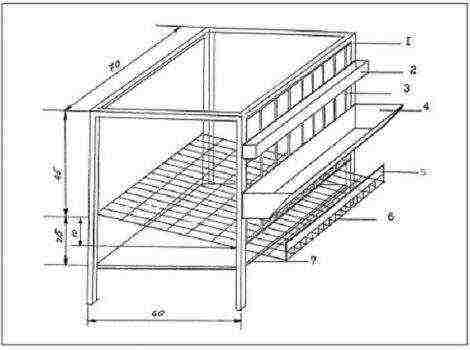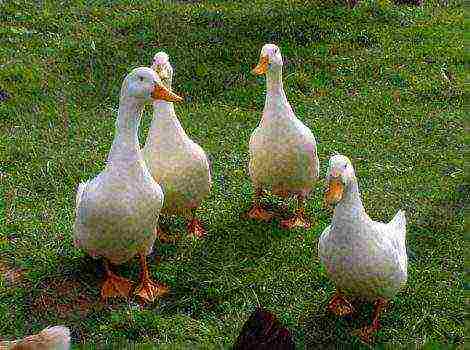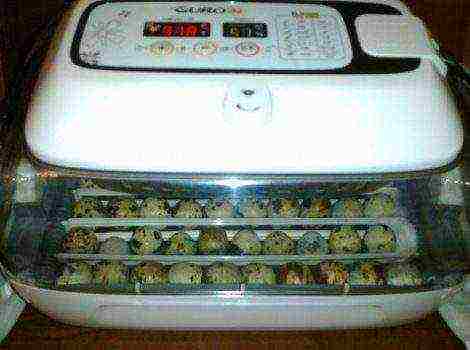Content
Chicken meat is always popular, therefore, with a rational approach to choosing a meat breed of chickens, breeding broilers can be quite a profitable activity. An excellent option is the Cobb 500 broilers. Due to its fast growth rates at low feed costs, this cross is very popular both in Russia and abroad.
In this article we will talk about the description of Cobb 500 broiler chickens, their characteristics, we will learn how to cope with diseases of the 500 cross. Among other things, we will learn the nuances of raising Cobb 500 broiler chickens at home.
Description of the breed of broiler Cobb 500
Let's start with the characteristics of Cobb 500 chickens. It differs from other breeds by its natural yellow skin color, which is in constant demand among consumers. The bird is quite unpretentious, does not need specialized expensive care or expensive feed, at the same time, slaughter can be carried out in a month and a half, which makes broiler breeding an extremely profitable enterprise.
Chickens cross cobb 500 are distinguished by their massive constitution, large strong paws. The plumage is snow-white. The neat comb and earrings are deep red in color. The head is completed with a massive beak.
Cobb broiler chick temperament 500
Due to the fact that broiler keeping is aimed at obtaining the maximum amount of meat, it is not recommended to settle the Cobb 500 in a regular poultry house with a walk. Optimal conditions for high productivity will be outdoor maintenance without walking, or stay in cages. When the bird is kept in cages, the mobility of the bird is sharply limited, and therefore the rate of weight gain increases.
They are quite phlegmatic, not aggressive, however, if kept incorrectly, some young individuals may suffer from cannibalism. The reason for this may be excessive brightness of the lighting, or an insufficiently complete diet. In the presence of these factors, individual chicks can peck at weaker fellow tribesmen up to death.

Cross Cobb 500 can be kept both on a small farm and in large poultry farms. When breeding poultry in a subsidiary farm, it should be taken into account that chicks require intense heat and light in the first days of life. For good weight gain, chickens need to peck frequently, which is impossible in the dark, so the first 14 days should be illuminated around the clock.
After this period, "daylight hours" are reduced to 18 hours. House temperatures should be between 27-32 degrees. The room should be well ventilated, but free of drafts that are harmful to the chicks. Particular attention should be paid to the cleanliness of the premises to prevent morbidity in chickens, therefore, before settling in a new batch of chickens, a general cleaning of the poultry house should be carried out by whitewashing the walls and ceiling with lime, changing the litter and thoroughly washing out the feeders and drinkers.
One of the differences in the cross is uniformity. That is, all livestock after reaching a certain age has approximately the same weight. Already a month the weight of chicks exceeds 2 kg, and in one and a half birds weigh on average 2500-2600, and in 56 days the weight of a bird is over 3 kg.
However, upon reaching the age of 80 days, the growth rates are significantly reduced, therefore the most favorable period for slaughtering chickens of this cross fluctuates in the region of 40-60 days, although the slaughter of young animals can be performed within 30 days from the moment of birth.
Egg production of the breed
The cross was developed by crossing breeds such as the Cornish and Plymouth Rock.In addition to the two main varieties, several other types of domestic chickens were used to obtain the Cobb 500 hybrid. As a result, the resulting cross is distinguished by excellent weight already in the first weeks of life, which can significantly save money on keeping the poultry.
The meat itself has a pleasant taste, ideal for dietary meals. Actually, thanks to painstaking crossbreeding in order to obtain a meat breed, an excellent broiler was bred, which, of course, will most likely be carried, like any bird, but it is simply pointless to hope for a high degree of egg production. In the best case, the number of eggs from under one female will be equal to 2-3 pieces per week.
Breeding, unlike egg breeds of chickens, broilers start quite late, not earlier than the age of 7 months.
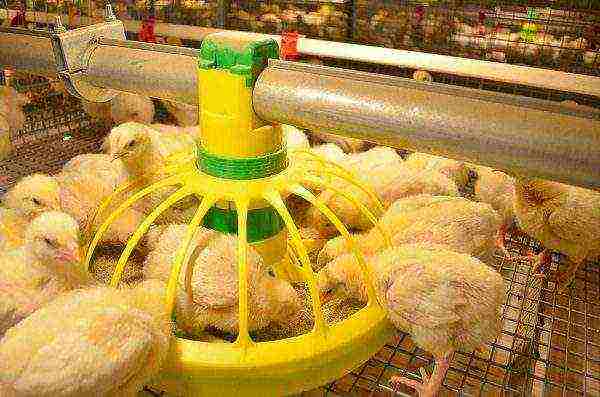
Breeding and growing Czech broilers at home
Traditionally, two methods are used for breeding Czech broilers Cobb 500.
- Purchase of hatching eggs at large poultry farms.
- Purchase of daily young animals.
You may also be interested to know:
How to grow broilers at home.
How and what to feed broiler chickens from the first days of life.
How to choose and make compound feed for broilers.
There are several reasons why traditional breeding of this type of chicken is not possible.
- Like most broilers, the Cobb 500 is a cross, in other words a hybrid from mixing different breeds. The qualities obtained by mixing breeds are not inherited.
- Due to the weakly expressed maternal instinct, hens of this species are not capable of incubating and raising offspring.
Of course, the cost of hatching eggs will be lower, however, buying already born chicks, you can clearly see the quality indicators, especially since the young Cobb 500 has a high survival rate, which is one of the advantages of breeding this cross.
The most important factors to consider when breeding Cobb 500 chicks.
- Conditions of detention. As the result of broiler raising is meat production, keeping conditions should be conducive to early weight gain. With excessive activity of young animals, the indicators of weight gain will be lower, which will reduce the profitability of poultry breeding.
- Temperature conditions. Birds cannot stand stuffiness, drafts, too high or low temperatures. If the chicks are crowded in one place in the immediate vicinity of the heaters, this indicates a temperature that is not comfortable enough for the chicks. At an excessively high temperature, the chickens become lethargic, lose their appetite, suffer from the heat, so the recommended temperature for birds should be in the range of 30 degrees, permissible fluctuations are from 27 to 33.
- Light mode. In the first 14 days of life, it is necessary to organize round-the-clock lighting, after which it is possible to reduce the hours of light supply.
- Good nutrition. The presence of vitamins, trace elements and mineral supplements in the feed for chicks is mandatory. The feed must be sufficiently rich in protein.
- Compliance with cleanliness in the room, where the broller chickens are kept. Despite the fact that these broilers are less susceptible to infections and diseases than other types of chickens, non-observance of cleanliness can lead to morbidity up to the death of a significant part of the livestock.
To feed babies, you can also use ready-made commercial feed PK-5 for young animals, you can prepare feed at home. When preparing feed on your own, it should be borne in mind that greens, small shells, chalk must be added to the feed mixture.
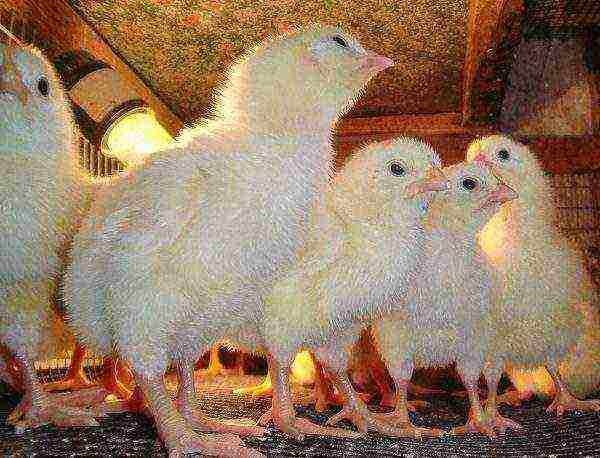
At first, chickens can be given a boiled egg, cottage cheese. The feed of the first days should be easily digestible, taking into account the characteristics of an immature digestive system. With the addition of cereals to the diet, it should be borne in mind that with an increased content of wheat in food, the level of assimilation of potassium with phosphorus decreases, which requires additional replenishment.
Chicks should be fed a lot and often. In the first week of life, chicks are given food 7-8 times a day, reducing the number of feedings by two times each subsequent week, until the bird reaches one month of age, when food can be given twice a day - in the morning and in the evening.
Cross diseases
Cobb 500s have low disease susceptibility and good survival rates, but they can also be susceptible to various diseases that commonly affect chickens. Here are some of the most common diseases that broilers may be exposed to.
- Dyspepsia. Most often, the disease is caused by expired or unsuitable for age food, which the chicks are not able to digest due to the insufficiently developed digestive system and the lack of necessary enzymes. The disease affects chickens in the first time after birth. With dyspepsia, severe poisoning of the body is observed, which manifests itself in the form of liquid excrement of white or yellow color with undigested food particles against a background of weakness and lack of appetite.
- Bronchopneumonia. May occur against the background of hypothermia. It can be determined by the severity of breathing with an open beak, wheezing when breathing, stretching the neck. Treatment should be prescribed by a veterinarian, otherwise the death of a sick bird is possible.
- Marek's disease. The incidence of it in broilers can reach 85%. Symptoms include lameness, drooping of the wings and tail, twisting of the neck, and sometimes full or partial visual impairment. An accurate diagnosis can only be made by a veterinarian.
- Avitaminosis. Due to their rapid growth, vitamin deficiencies in broilers can be felt much more acutely than in non-beef chickens. To prevent vitamin deficiency, the poultry ration should be additionally enriched with vitamins when feeding poultry with non-specialized feed, where the composition already contains the required amount of necessary substances.
- Enteritis. Inflammation of the gastrointestinal tract. Young chickens are susceptible, treatment is carried out with drugs of an antibacterial spectrum of action.
- Aspergillosis. A disease caused by a fungus affects the respiratory tract. As a rule, aspergillosis occurs when the conditions of detention are violated, which contributes to the reproduction of the fungus.
- Salmonellosis. A disease that is dangerous not only for chickens, but also for humans. In case of infection with salmonellosis, sick individuals are subject to slaughter without being used for food.
Advantages and disadvantages
Summing up, the following advantages of the Cobb 500 cross can be highlighted.
- Rapid weight gain in an extremely short time, allowing broilers to be slaughtered from the age of 30 days.
- Yellow pigmentation of the skin.
- Low feed costs.
- High survival factor.
- Suitable for breeding both in large poultry farms and for small subsidiary farms.
- Low susceptibility to common chicken diseases.
- Uniformity of individuals of the same age of both sexes.
The disadvantages of broilers of this type include the lack of the possibility of breeding in the traditional way for birds and intolerance to cold, which significantly increases the energy consumption in the process of growing in some regions in more severe climatic zones.
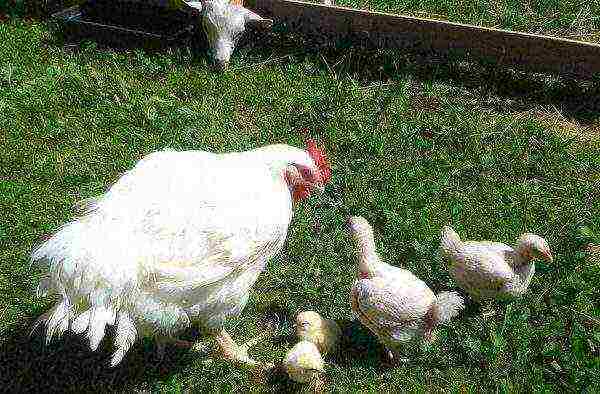
Table of the ratio of weight and feed consumption of broiler chickens
Below is a table that clearly shows the ratio of weight and feed consumption for broiler chicken.
| Age, days |
Live weight, Kg |
Feed consumption, g / day |
Feed consumption from the beginning of feeding, g / head |
| 0 | 0,042 | 0 | 0 |
| 1 | 0,052 | 14 | 14 |
| 2 | 0,066 | 14 | 28 |
| 3 | 0,082 | 15 | 43 |
| 4 | 0,100 | 16 | 59 |
| 5 | 0,120 | 22 | 81 |
| 6 | 0,142 | 25 | 106 |
| 7 | 0,166 | 28 | 134 |
| 8 | 0,193 | 31 | 165 |
| 9 | 0,223 | 35 | 200 |
| 10 | 0,256 | 39 | 239 |
| 11 | 0,293 | 44 | 283 |
| 12 | 0,334 | 49 | 332 |
| 13 | 0,379 | 55 | 387 |
| 14 | 0,427 | 61 | 448 |
| 15 | 0,478 | 68 | 516 |
| 16 | 0,532 | 75 | 591 |
| 17 | 0,589 | 83 | 674 |
| 18 | 0,649 | 91 | 765 |
| 19 | 0,712 | 99 | 864 |
| 20 | 0,778 | 106 | 970 |
| 21 | 0,846 | 112 | 1082 |
| 22 | 0,916 | 118 | 1200 |
| 23 | 0,988 | 123 | 1323 |
| 24 | 1,062 | 128 | 1451 |
| 25 | 1,137 | 133 | 1584 |
| 26 | 1,213 | 137 | 1721 |
| 27 | 1,290 | 141 | 1862 |
| 28 | 1,368 | 145 | 2007 |
| 29 | 1,447 | 149 | 2156 |
| 30 | 1,527 | 153 | 2309 |
| 31 | 1,608 | 157 | 2466 |
| 32 | 1,690 | 160 | 2626 |
| 33 | 1,773 | 163 | 2789 |
| 34 | 1,857 | 166 | 2955 |
| 35 | 1,942 | 169 | 3124 |
| 36 | 2,027 | 172 | 3296 |
| 37 | 2,112 | 175 | 3471 |
| 38 | 2,196 | 177 | 3648 |
| 39 | 2,279 | 179 | 3827 |
| 40 | 2,361 | 181 | 4008 |
| 41 | 2,442 | 182 | 4190 |
| 42 | 2,522 | 183 | 4373 |
| 43 | 2,601 | 184 | 4557 |
| 44 | 2,679 | 185 | 4742 |
| 45 | 2,756 | 186 | 4928 |
| 46 | 2,833 | 187 | 5115 |
| 47 | 2,909 | 188 | 5303 |
| 48 | 2,984 | 188 | 5491 |
| 49 | 3,058 | 188 | 5679 |
Cobb 500 broilers can be an excellent option for both small farms and industrial poultry because these birds do not need long-term feeding to gain optimal weight, which is very effective in terms of cost-benefit ratio.
Even in a small area during the summer season, 2-3 generations of Cobb 500 can be grown, the meat of which has excellent taste and an attractive presentation, enjoying high consumer demand.
Anton: It is a troublesome business, but very profitable, I do not regret the time spent (and it takes a lot). Contained in a cellular manner. The first batch of chickens was received with the help of an incubator (Hen). It turned out well, because I strictly adhered to the recommendations. The second batch of 150 pieces was purchased at the poultry farm after the first was sold.
They grow well on mixed fodders, weight gain was controlled by weighing 10% of the number of birds. The weight increased only slightly behind the norm.
He collected the cells himself from scrap materials, but according to the description in the special literature. I bought only special drinkers.
In general, I finish bragging and summarize: it's worth working, because you will get not only high-quality meat, but also a good income. Now, I have already ordered the first batch for this year for the end of February (there is no time to fiddle with the incubator now) and I will take up this business closely.
Kostya Ufimtsev: Raised broilers for meat. I am pleased with the result: a huge amount of very tasty meat. Enough for your own food, and for sale. The main thing is to adhere to the breeding rules and everything will work out. Bird magazine
